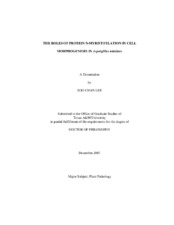| dc.description.abstract | Polarized hyphal growth dominates the life cycle of filamentous fungi and is
essential to disease progression for many fungal pathogens. Despite its importance,
much of the basic biology controlling the process remains to be elucidated. Protein Nmyristoylation
is one process important to hyphal growth for which the direct
mechanism for this connection is not understood. N-myristoylation is mediated by Nmyristoyltransferase
(NMT), which links 14-carbon myristate to target proteins. In
Aspergillus nidulans, a mutation in the NMT gene (swoF1) results in abnormal
morphogenesis during spore germination and the establishment of hyphal polarity. I
hypothesize that a protein or proteins downstream of NMT are important for polarized
hyphal growth.
Using a forward genetic approach, I obtained six suppressors of swoF1. I found
that three were proteasome-related and a mutation in genes encoding 26S proteasome
subunits by-passed the polarity defects of swoF1. Interestingly, N-myristoylation
negatively regulated the activity of the 26S proteasome. This result was confirmed by
treating with the proteasome inhibitor MG132. This is the first finding of a connection
between N-myristoylation and proteasome function during polarized growth. To identify targets by reverse genetic analysis, I found that 41 proteins (of more
that 10,000 encoded by the organism) were predicted to be myristoylated in silico. Three
were ADP ribosylation factors (ARF), proteins known to be involved in vesicle
formation and trafficking in other systems. I chose ArfA (AN1126.3), ArfB (AN5020.3),
and ArlA (AN5912.3) for further characterization of polarization in this study.
ArfA::GFP discretely localized to endomembrane likely to be Golgi bodies. ArfB::GFP
localized to septa and plasma membrane. N-myristoylation determined the localization
of both ArfA and ArfB. Disruption of the arfB gene resulted in loss of polarity
establishment and endocytosis. Together these results suggest that endocytosis plays an
important role in maintaining hyphal polarized growth and in shaping the cell apex. | en |


